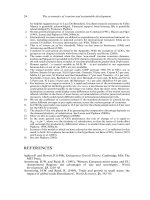THE ECONOMICS OF MONEY,BANKING, AND FINANCIAL MARKETS 409
Bạn đang xem bản rút gọn của tài liệu. Xem và tải ngay bản đầy đủ của tài liệu tại đây (31.27 KB, 1 trang )
CHAPTER 14
Risk Management with Financial Derivatives
377
S U M M A RY
1. Interest-rate forward contracts, which are agreements to sell a debt instrument at a future (forward)
point in time, can be used to hedge interest-rate risk.
The advantage of forward contracts is that they are
flexible, but the disadvantages are that they are subject to default risk and their market is illiquid.
2. A financial futures contract is similar to an interestrate forward contract in that it specifies that a debt
instrument must be delivered by one party to
another on a stated future date. However, it has
advantages over a forward contract in that it is not
subject to default risk and is more liquid. Forward
and futures contracts can be used by financial institutions to hedge (protect against) interest-rate risk.
3. Stock index futures are financial futures whose
underlying financial instrument is a stock market
index. Stock index futures can be used to hedge
stock market risk by reducing systematic risk in portfolios or by locking in stock prices.
interest-rate risk in a similar fashion to the way they
use financial futures and forward contracts. Futures
options may be preferred for macro hedges because
they suffer from fewer accounting problems than
financial futures.
5. Interest-rate swaps involve the exchange of one set
of interest payments for another set of interest payments and have default risk and liquidity problems
similar to those of forward contracts. As a result,
interest-rate swaps often involve intermediaries
such as large banks and investment banks that make
a market in swaps. Financial institutions find that
interest-rate swaps are useful ways to hedge interestrate risk. Interest-rate swaps have one big advantage
over financial futures and options: They can be written for very long horizons.
6. Credit derivatives are a new type of derivative that
offer payoffs on previously issued securities that have
credit risk. These derivatives credit options, swaps,
and credit-linked notes can be used to hedge credit
risk.
4. An option contract gives the purchaser the right to
buy (call option) or sell (put option) a security at the
exercise (strike) price within a specific period of
time. The profit function for options is nonlinear
profits do not always grow by the same amount for
a given change in the price of the underlying asset.
The nonlinear profit function for options explains
why their value (as reflected by the premium paid
for them) is negatively related to the exercise price
for call options, positively related to the exercise
price for put options, positively related to the term to
expiration for both call and put options, and
positively related to the volatility of the prices of
the underlying asset for both call and put options.
Financial institutions use futures options to hedge
7. There are two major concerns about the dangers of
derivatives: They allow financial institutions to more
easily increase their leverage and take big bets (by
effectively enabling them to hold a larger amount of
the underlying assets than the amount of money
put down), and they expose financial institutions to
large credit risks because the huge notional amounts
of derivative contracts greatly exceed the capital of
these institutions. The second danger seems to be
overplayed, but the danger from increased leverage
using derivatives is very real, as events in the subprime financial crisis revealed.
KEY TERMS
American option,
arbitrage,
p. 362
p. 351
exercise price (strike price), p. 361
long position,
p. 346
financial futures,
macro hedge,
p. 353
p. 349
at the money (trading at par)
option, p. 363
financial futures option (futures
option), p. 362
margin requirement,
call option, p. 362
forward contracts,
micro hedge, p. 353
call premium,
in the money option,
p. 362
credit derivatives,
p. 374
credit-linked note,
credit options,
credit swap,
p. 375
p. 374
p. 375
currency swaps,
European option,
p. 370
p. 362
p. 347
p. 363
interest-rate forward contract,
p. 347
interest-rate futures contract, p. 349
interest-rate swaps, p. 370
intrinsic value,
long in a call,
p. 363
p. 362
long in a put, p. 364
p. 355
marked to market, p. 355
notional principal,
open interest,
p. 371
p. 353
option, p. 361
out of the money option, p. 363
premium,
p. 362
put option, p. 363
put premium,
p. 364









